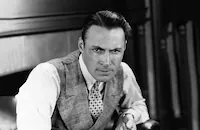Hi, Gaucho!

Brief Synopsis
Cast & Crew
Tommy Atkins
John Carroll
Steffi Duna
Rod La Roque
Montagu Love
Ann Codee
Film Details
Technical Specs

Synopsis
While driving cattle across the Argentine pampas of the eighteenth century, gaucho Lucio meets the beautiful Inez del Campo, who is traveling to her mother's home, and instantly falls in love with her. Unknown to Lucio, Inez's mother, Doña Vicenta, has arranged for Inez to marry Don Salvador de Aragon, an impoverished but aristocratic Spaniard. Unknown to Doña Vicenta, however, the elderly Don Salvador has been kidnapped by the infamous bandit Escurra, a former captain of the king's guard whom Don Salvador recognizes during a stagecoach robbery. Escurra, seeing a portrait of Inez, steals Don Salvador's clothes and presents himself to Doña Vicenta as Inez's husband-to-be. Although Inez desires Lucio, she submits to her mother's will and prepares for her marriage. The proud, strong-willed Lucio, however, refuses to accept Inez's engagement and vows to make her his bride. When Doña Vicenta, who has been feuding for years with Lucio's rancher father Hillario, finds Lucio serenading Inez, she yanks her daughter away and forbids her from seeing Lucio. Undaunted, Lucio sneaks into Doña Vicenta's house and snatches a woman he believes is Inez, only to discover later that he has grabbed her mother. Overcome with anger, Doña Vicenta gives orders to arrest Lucio, but he evades capture. At the same time, Hillario and his men are scouring the pampas in search of Escurra's bandits, who have stolen their cattle. The fugitive Lucio meets up with his father, and the two of them ride back to Doña Vicenta's, determined to win Inez from Don Salvador. After Hillario and Lucio disrupt Inez's pre-nuptial party, the real Don Salvador is brought in by Hillario's men. Escurra is arrested, and Hillario convinces Dona Vicenta to end their feud and allow Inez to marry Lucio.

Director
Tommy Atkins
Cast

John Carroll

Steffi Duna

Rod La Roque

Montagu Love
Ann Codee
Tom Ricketts
Paul Porcasi
Enrique Derosas
Julian Rivero
Frank Mills
Sam Appel
Harold Daniels
Ferike Boros
Crew
Tommy Atkins
Adele Buffington
John E. Burch
Sturges Carne
P. J. Faulkner Jr.
Fred Knudtson
Jack Mackenzie
Albert Hay Malotte
Walter Plunkett
Van Nest Polglase
Earl A. Wolcott

Film Details
Technical Specs

Articles
Hi Gaucho -
By Violet LeVoit

Hi Gaucho -
Quotes
Trivia
Notes
John Carroll made his screen debut in this film. According to a Daily Variety news item, Enrico de Rosas, a star of Spanish language films, convinced director Tommy Atkins to cast him in Hi, Gaucho! after he rode out to Calabasas, where the film was being shot, and proved that he could handle the dialogue. Hollywood Reporter production charts add Sidney D'Albrook and Jack Rice to the cast, but their participation in the final film has not been confirmed.














